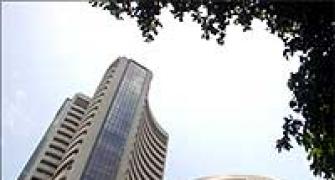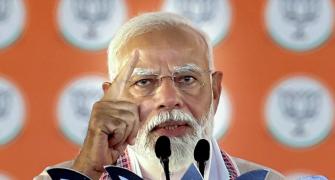 For the first time since April 1997, growth in bank credit has dropped to single-digit levels, an indication that demand is yet to pick up. For the year up to October 23, bank credit flow grew by 9.65 per cent. This is the slowest pace of increase since April 25, 1997 when the growth rate was 9.61 per cent.
For the first time since April 1997, growth in bank credit has dropped to single-digit levels, an indication that demand is yet to pick up. For the year up to October 23, bank credit flow grew by 9.65 per cent. This is the slowest pace of increase since April 25, 1997 when the growth rate was 9.61 per cent.
During the fortnight-ended October 23, bank credit shrank Rs 21,750 crore (Rs 217.5 billion) to Rs 28,90,316 crore (Rs 28,903.16 billion) against an increase of Rs 7,637 crore (Rs 76.37 billion) in the corresponding period last year, according to the latest data released by the Reserve Bank of India on Wednesday evening.
A year ago, as the global financial crisis sapped out liquidity, companies were forced to hunt for local sources of funding and pushed up overnight rates to over 20 per cent levels. On a year-on-year basis, credit grew at 29 per cent at the end of October 24, 2008.
What has also skewed the picture is the lower demand of funds from oil and fertiliser companies. Last year, these companies had borrowed heavily with the government deferring subsidy payments on fuel prices.
Apart from the base effect, bankers said that the reliance of companies on non-bank sources, such as commercial paper, had increased. Also, a large number of companies have tapped the equity markets to raise resources and some, such as real estate companies, have also repaid bank loans.
"The dependence of companies on non-bank resources has gone up to 60 per cent, while banks are chipping in the rest," said Union Bank of India Chairman and Managing Director M V Nair.
In addition, companies, which had planned projects have put them on hold as overseas and local demand fell in the last few months. While there were signs of an increase in disbursal of loans sanctioned by banks, Nair, who also heads the Indian Banks' Association, said, these were initial signs.
Further, growth in retail loan flow has also been tepid with banks choosing to play it safe fearing delinquency. As a result, up to the end of August, the latest period for which disaggregated data has been released by RBI, year-on-year growth in retail loans was 2.3 per cent.
Within this, credit card outstandings and consumer durables finance, shrank as banks such as ICICI Bank, which was the largest player in the segment, remained largely dormant in the space.
The disaggregated data for the year up to August also showed that lending by foreign banks fell over 15 per cent.
ICICI Bank, the country's largest bank, has continued to shrink its balance sheet and expects moderate growth in home, auto and corporate loans. In contrast, public sector players, such as State Bank of India, are expecting a growth rate of around 22 per cent during the year up to March 2010.
For the year up to March, RBI has projected that credit flow would rise by 18 per cent, as against 20 per cent estimated in April 2009.
But bankers said that even the new target could be difficult to achieve. "The demand for working capital by companies has not yet picked up. So, overall growth may be lower than RBI's projection," said a public sector bank chief.
"We don't expect credit growth to cross the 15 per cent level for some time. There is some demand coming from agriculture but industrial demand is low. There are some sectors like infrastructure, consumer durables and housing loans, which look promising but they cannot, substitute industrial demand. We do not expect buoyancy in credit demand until some large projects take off and the global markets fully recover," said a senior executive at a leading private bank.
YM Deosthalee, chief financial officer of Larsen and Toubro, said companies would borrow from banks if the options were attractive. "While infrastructure companies still borrow from banks because of growing demand, the consumption-oriented borrowing, especially for housing and auotmotive, has to pick up", he said.
Dev Bhattacharya, group executive president, corporate strategy and business development, A V Birla Group, said there was no genuine demand for credit as the manufacturing industry was finding only soft demand growth from the larger urban market. "There is demand from the rural market but we will have to see if that can sustain the overall growth for manufacturing industry," he said.
Some like Abheek Barua, chief economist, HDFC Bank, felt the drop in credit growth is largely due to the base effect, though things have improved sequentially. "Disintermediation was bit of an issue; companies have been raising money abroad. But the fall in growth is largely due to the base effect. When the credit crisis kicked in, everyone switched to domestic sources of funds. So, there was spike in credit growth, and hence YoY, credit growth came down sharply," he said.
The lack of lending can be gauged from banks parking over Rs 1,33,295 crore (Rs 1,332.95 billion) with the RBI through the reverse repo window that is used to suck out excess liquidity from the system. Since April, banks have continuously parked over Rs 1,00,000 crore (Rs 1,000 billion) on a daily basis through the reverse repo window.
According to the RBI data, food credit fell by Rs 6,708.26 crore (Rs 67.08 billion) to Rs 36,012 crore (Rs 360.12 billion) at the end of October 23, 2009.
Deposit mobilisation by banks fell by Rs 8,408 crore (Rs 84.08 billion) to Rs 41,52,946 crore (Rs 41,529.46 billion) during the fortnight ended October 23. On a year-on-year basis bank depositswent up by 19 per cent against nearly 20 per cent for the fortnight-ended October 9.
This was partly the result of lower interest rates. Around the same time last year, banks were between 8.75 per cent and 10.5 per cent on deposits, which has now dropped to 6.25-7.5 per cent.
As a result, time deposits -- which have a tenure of over a year -- dropped by Rs 11,254 crore (Rs 112.54 billion) during the fortnight-ended October 23, 2009. In contrast, demand deposits, which have a tenure of less than a year, went up by Rs 2,845 crore (Rs 28.45 billion).
Lower deposit mobilisation resulted in a Rs 24,703 crore (Rs 247.03 billion) decline in bank investment in government securities that qualify for meeting the statutory liquidity ratio.







